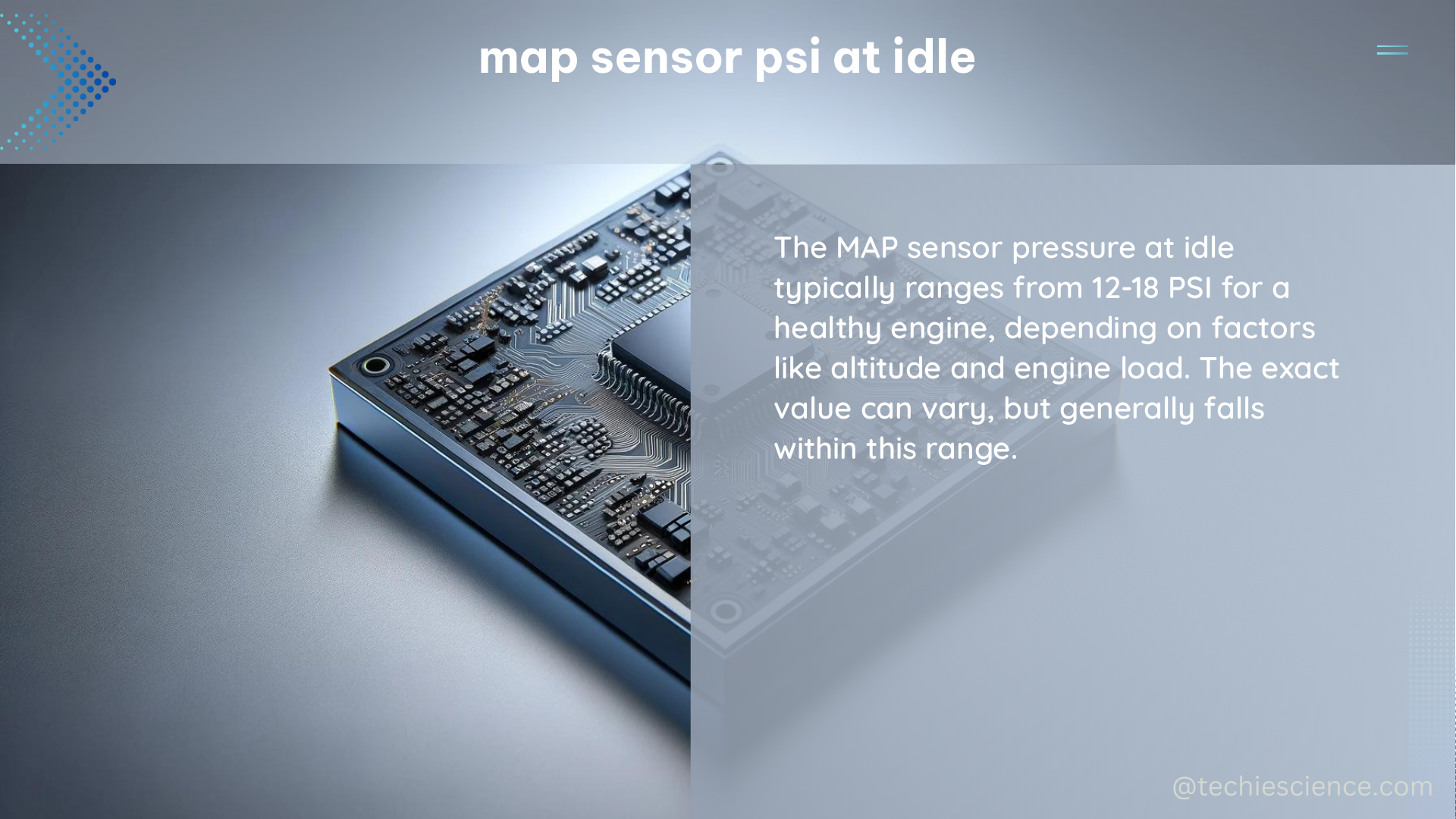The Manifold Absolute Pressure (MAP) sensor is a critical component in modern engine management systems, responsible for providing the Engine Control Unit (ECU) with vital information about the air pressure inside the engine’s intake manifold. At idle, the MAP sensor’s reading can provide valuable insights into the engine’s performance and overall health. In this comprehensive guide, we’ll delve into the intricacies of MAP sensor PSI at idle, equipping you with the knowledge to diagnose and troubleshoot any issues related to this crucial sensor.
The Role of the MAP Sensor
The MAP sensor measures the absolute air pressure in the engine’s intake manifold, which can range from a vacuum (negative pressure) to a pressure higher than atmospheric pressure, particularly in turbocharged engines. This pressure information is then translated by the MAP sensor into an electrical signal voltage that the ECU can interpret. The ECU uses this signal to determine the amount of air entering the combustion chambers, allowing it to adjust the fuel delivery and ignition timing accordingly.
Understanding MAP Sensor Readings at Idle

At idle, the MAP sensor should typically measure a pressure of 14.2-15.0 psi (98-103 kPa), depending on the atmospheric pressure. This range is considered the typical range of atmospheric pressure, which can vary depending on factors such as altitude and weather conditions.
However, it’s important to note that the actual MAP sensor reading at idle can vary depending on the engine type, size, and other factors. For example, a larger camshaft can result in a lower idle vacuum, leading to a higher MAP reading at idle.
To get a more accurate understanding of your engine’s MAP sensor readings at idle, it’s recommended to consult the manufacturer’s specifications or refer to service manuals specific to your vehicle model.
Measuring MAP Sensor Signal Voltage
To measure the MAP sensor signal voltage, you’ll need to use a lab scope or a multimeter. Here’s a step-by-step guide on how to do it:
- Connect the lab scope’s Channel 1 to the signal voltage output of the MAP sensor.
- Connect the lab scope’s Channel 2 to the positive side of the sensor’s power supply.
- Connect the lab scope’s ground lead to the negative side of the sensor’s power supply (ground at the battery).
- Set the lab scope to recorder mode and observe the live display of the measured signals.
When measuring the MAP sensor signal voltage, you should expect to see the following:
| Channel | Voltage |
|---|---|
| Channel 1 (Signal voltage output) | Approximately 8 V |
| Channel 2 (Positive side of sensor power supply) | Approximately 8 V |
It’s important to note that the signal band becomes wider at higher RPMs due to larger pressure variations.
Troubleshooting MAP Sensor Issues
Signal deviations from the expected values can indicate a problem with the MAP sensor or the engine control system. Here are some common issues and their potential causes:
- High signal voltage: This can indicate a poor or no ground on the power supply, a vacuum circuit leak, or a sensor defect.
- Signal noise: Damaged wiring of the signal or power supply, or poor connection in connector terminals can cause signal noise.
- Offset in the signal: This can indicate a poor power supply to the MAP sensor or a sensor defect.
If you encounter any of these issues, it’s recommended to perform further diagnostic tests, such as checking the sensor’s wiring, power supply, and ground connections, as well as verifying the sensor’s operation with a lab scope or multimeter.
Conclusion
The MAP sensor is a crucial component in modern engine management systems, and understanding its behavior at idle is essential for maintaining optimal engine performance. By familiarizing yourself with the typical MAP sensor PSI at idle, the process of measuring the signal voltage, and common troubleshooting techniques, you’ll be better equipped to diagnose and address any issues related to this important sensor.
Remember, always refer to the manufacturer’s specifications and service manuals specific to your vehicle model for the most accurate and up-to-date information.
References
- TiePie Automotive, “Measuring a MAP sensor”, https://www.tiepie-automotive.com/en/articles/map-sensor
- Ross-Tech Forum, “P0106 – Is it as simple as a bad/wrong MAP sensor?”, https://forums.ross-tech.com/index.php
- Duramax Forum, “Normal Manifold Absolute Pressure at Idle”, https://www.duramaxforum.com/threads/normal-manifold-absolute-pressure-at-idle.1019278/
- LS1TECH, “Map reading 67kPa at idle??”, https://ls1tech.com/forums/generation-iv-external-engine/1113617-map-reading-67kpa-idle.html
- S-10 Forum, “Manifold absolute pressure psi?”, https://www.s10forum.com/threads/manifold-absolute-pressure-psi.861878/

The lambdageeks.com Core SME Team is a group of experienced subject matter experts from diverse scientific and technical fields including Physics, Chemistry, Technology,Electronics & Electrical Engineering, Automotive, Mechanical Engineering. Our team collaborates to create high-quality, well-researched articles on a wide range of science and technology topics for the lambdageeks.com website.
All Our Senior SME are having more than 7 Years of experience in the respective fields . They are either Working Industry Professionals or assocaited With different Universities. Refer Our Authors Page to get to know About our Core SMEs.